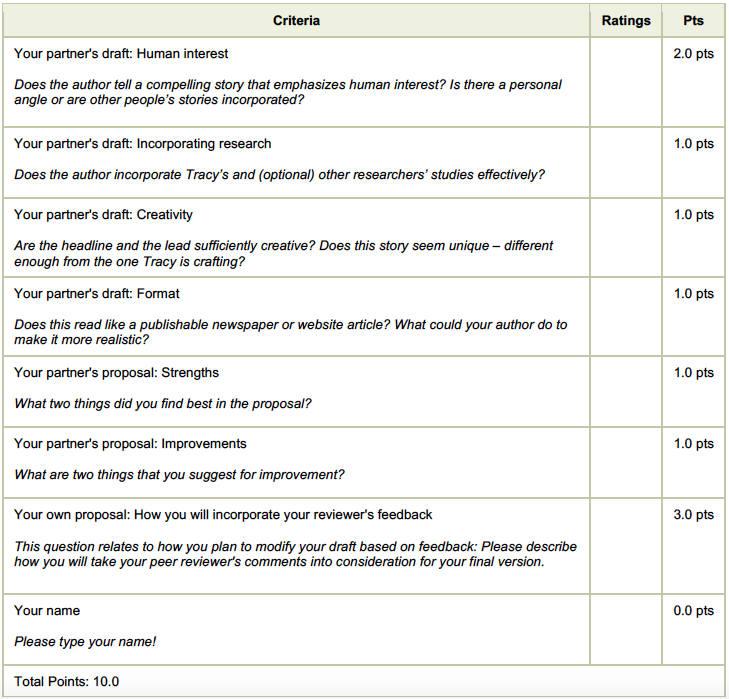Professor Sara McKinnon (Communication Arts 260)
Draft due Monday, March 19th, 12pm (noon). Peer review rubric due Wednesday, March 21st, 11:59pm.
Please use the hard copy of your peer review activity from the in-person writing workshop to complete this peer review rubric.
You may paraphrase your comments, but you must be accurate and honest. Please also honestly indicate how you incorporated your peer’s comments into your final draft; is it not required that you incorporate your peer’s comments, but you do need to explain why/why not.
You’ll be using a peer review rubric on a 10 point scale. Full credit is subject to TA/instructor review, and any grade adjustments will be communicated to you by your TA.
The human interest story prompt and requirements are listed below.
Imagine you are a freelance journalist who is trying to develop a publishable story about the challenges and dangers of jobs that involve emotion labor. You are basing your story off of Tracy’s (2005) article entitled “Locking up emotion: Moving beyond dissonance for understanding emotion labor discomfort.” Though Tracy’s research focuses on the challenges of emotion management for correctional officers, your task is to extend understanding of this concept to a wide range of jobs where emotion is a key aspect of the work, and develop a human connection or angle to the concept.
The purpose of a human-interest story is to share unique insights into the human experience. People should be at the heart of such stories, but they should also seek to inform, raise awareness, educate, and give people new language or analysis for common human experiences.
The story should be composed of the following parts:
• A catchy headline: This is your title.
• An engaging lead: This is where you get your reader hooked into the article (1-2 paragraphs)
• The body of your story: This is where you develop the main content and key information that expands upon, and develops, what you begin in your lead. You can think of it as the hub, or as the “nuts and bolts” of the story (3-5 paragraphs).
• A satisfying conclusion: Your conclusion should summarize and tie up any necessary loose ends (questions asked in the article), and it should leave your readers with a lasting thought to ponder (1-2 paragraphs).
You should feel free to draw from other research on the theme of emotion labor if it helps you in composing your own story.
You should also feel free to draw from personal experience or the experience of others in order to develop the human angle. Toward this end, interviews with friends, family, or acquaintances may be useful to personalize the article.
Your final paper should be between 500-800 words (not including bibliography), and include a bibliography with properly formatted sources in APA (including the Tracy reading that you are required to cite). Include word count in parentheses at the end of the article.
Peer Review Rubric: Human Interest Story

Lorem ipsum dolor sit amet, consectetur adipiscing elit. Ut elit tellus, luctus nec ullamcorper mattis, pulvinar dapibus leo.